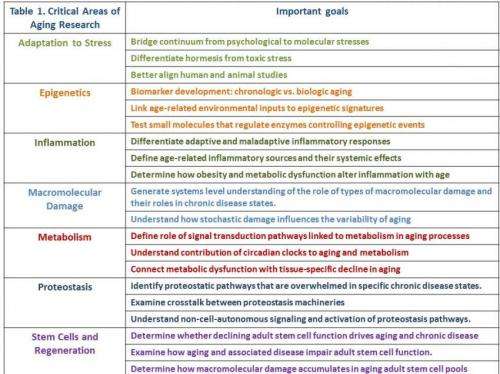Research strategy supports GSIG's efforts to integrate aging into chronic disease research

Scientists who have been successful in delaying mammalian aging with genetic, dietary and pharmacological approaches have developed a research strategy to expand Geroscience research directed at extending human healthspan. The strategy comes at a critical time, given the dramatic increase in the elderly population and a growing recognition that aging is the greatest risk factor for a majority of the chronic diseases that drive later-life disability and death. The strategy is set forth in a commentary published in the November 6th edition of Cell.
The scientists took part in the first summit of the NIH Geroscience Interest Group (GSIG) held last year on the NIH campus. The National Institutes of Health is made up of 27 different components called Institutes and Centers. Each has its own specific research agenda. The GSIG is aimed at promoting new pathways for collaboration, both within the NIH and with its funded researchers, specifically within the context of aging. The NIH was created and organized long before scientists began seriously exploring the possibility of altering the aging process.
"We have high hopes that our research strategy will help move collaborative efforts to the next level," said Brian Kennedy, PhD, President and CEO of the Buck Institute and the lead author of the commentary. "What has come out of our work is a keen understanding that the factors driving aging are highly intertwined and that in order to extend healthspan we need an integrated approach to health and disease with the understanding that biological systems change with age."
The "Pillars of Aging" and research goals are detailed in the following table:
The group focused on a limited set of short-and intermediate-term scientific goals that would accelerate Geroscience and launch novel approaches to reduce the impact of the healthcare burden associated with the chronic diseases of aging. The scientists call for Geroscience to be merged with ongoing research on human chronic disease states; an expansion of interventions that extend lifespan and healthspan; an elaboration of environmental and random factors driving aging; an integration of human genetic and epigenetic studies with animal models; a comparison and contrast of inflammation in aging and disease; and the development of new animal models of aging.
"Our current approach to researching and treating chronic diseases is inadequate and fragmentary," said Kennedy. "By the time chronic diseases are diagnosed, much damage is done and undoing it is difficult." Pointing out that 46 percent of Medicare spending is for people with six or more chronic conditions, Kennedy added, "Targeting aging may allow early intervention and allow us to maintain vigor and activity, while offsetting the economic burdens of a burgeoning aging population hampered by multiple chronic diseases."
More information: Aging: a common driver of chronic diseases and a target for novel interventions Cell, November 6, 2014.

















